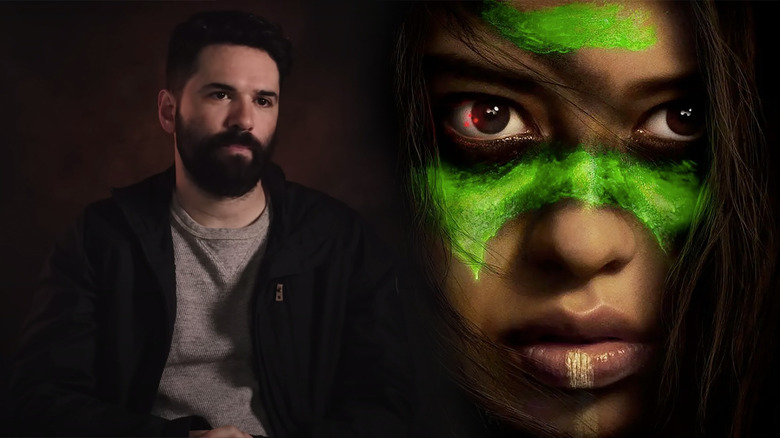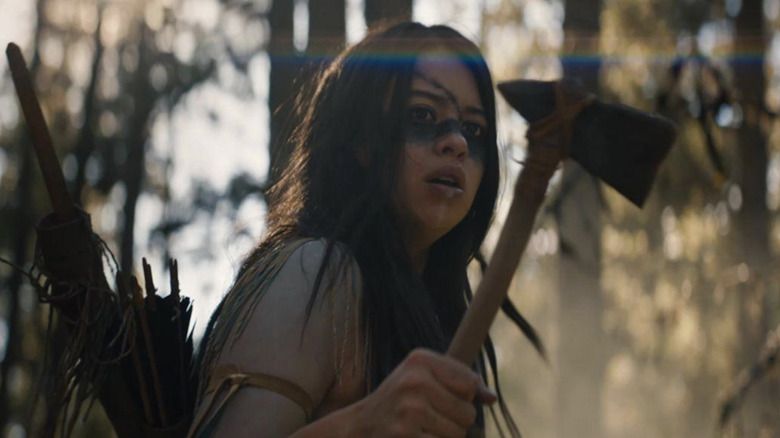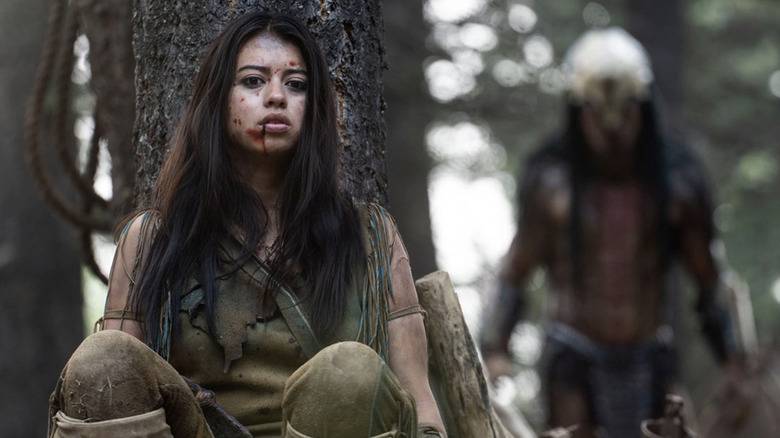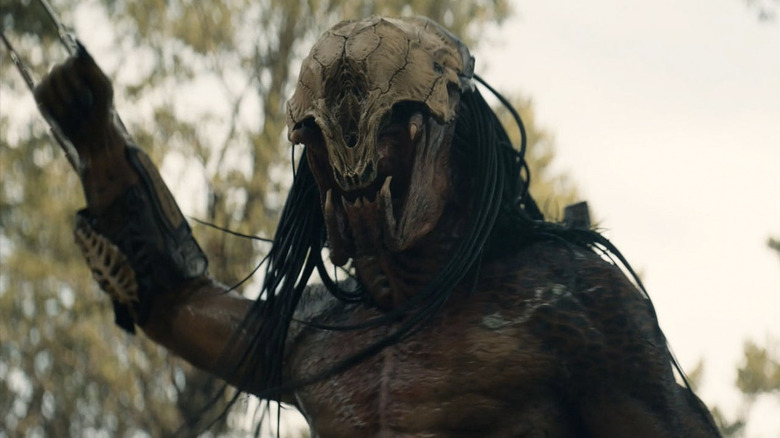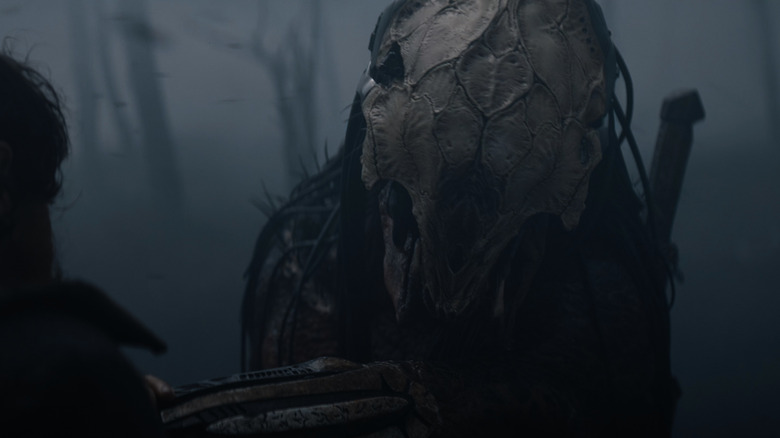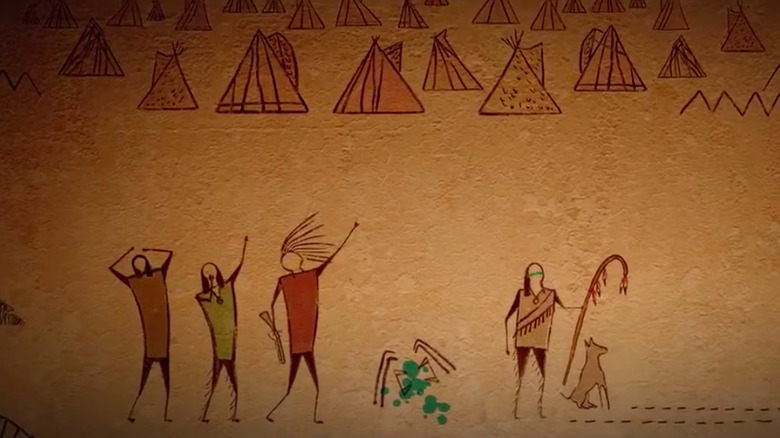Prey Director Dan Trachtenberg Talks Predator Weapons, A Little Directing Trick & More [Exclusive Interview]
Last year, "Prey" delivered the best new installment of the "Predator" franchise since the 1987 original. Director Dan Trachtenberg took us back to the early 1700s to deliver a story of courage and survival as a young Comanche woman named Naru finds herself coming face-to-face with a Predator, with only a hatchet, a bow and arrow, a trusty canine, and a few clever tricks to help her. That meant giving us an all-new Predator to hunt her down, and Trachtenberg was both excited and challenged by the prospect of helping to create a creature from hundreds of years ago.
Leading up the physical media release of "Prey" on 4K UHD, Blu-ray, and DVD today, we caught up with Dan Trachtenberg to ask him about developing new weapons for the Predator, how he came to focus on the Comanche as the protagonists, and a certain action sequence that never made it in front of cameras (though it can be seen in previz on in the home media special features). Plus, he mentions a few Easter eggs and clever bits you might have missed.
Note: This interview has been lightly edited for clarity and brevity.
'I really didn't want it to be a Western, like we so often see Native Americans represented in that time period'
Did you have to push for "Prey" to get a physical release? Or did the success on Hulu just convince Disney they were probably leaving money on the table by not releasing this to get physical media hounds after it?
On the one sense, yes, I had to push. But in another sense, the fans pushed, and I let them push me into the studio, and I pushed on the studio. Then, the studio pushed what they need to push. It really came from the desire of everyone online saying, "We must have discs." And then, frankly, the head of the studio is a rare breed, in that he's a fricking movie nerd. This guy, [20th Century Studios President] Steve Asbell, felt the same, and he has lots of movie box sets, and he knew his "Predator" one would be incomplete if this one didn't get a physical release. So here we are.
That's the second great thing I've heard about Steve Asbell this week. Because I interviewed Brian Duffield recently, and he couldn't have sung more praises about working with him on "No One Will Save You."
Yep. You will hear that from any movie coming out of that place, especially genre film. Steve is a real movie lover, movie nerd.
Awesome. So I've read some other interviews, and you talked about how the pistol from "Predator 2" helped give you this connection back to the 1700s and kind of brought about the idea for the setting. But I was curious, how did you come to settle on the Comanche as the driving force of the narrative? Because there's a variety of different paths you could have taken to do that in the 1700s, some even more direct. So what was it about the Comanche specifically that were just right for this movie?
Yeah, that came before the gun thought. I wanted to make an underdog story. I wanted to make a survival tale of someone proving themselves. [We] went to Native American, primarily, then, in thinking of where exactly to put the focus, Comanche, just in cinema history, have really been at the forefront of all the wrongheaded representation, from "The Searchers" to "The Lone Ranger." "The Searchers" has a very famous shot that has been visually referenced countless times, where we pushed through the silhouette of the doorframe to reveal John Wayne coming and John Wayne leaving. So early in the movie, in "Prey," we have a similar sequence of Naru with the teepee framing the sides of the frame, and we push past to directly reflect "The Searchers."
So that, and the gender dynamics of that tribe in particular, made it essential that it be a Comanche story. I wanted the movie to be as early as possible. I really didn't want it to be a Western, like we so often see Native Americans represented in that time period. I wanted to go back as far as we could. My initial thoughts were like, I don't even know if white people would show up, and what could that be? Then, taking a shower, I started thinking about it, thinking it through, and I was like, "The gun! The gun over there, what date was on the gun?! What date was on the gun?" And then, I got out of the shower and quickly found the image at the end. I was like, "Oh, my God, 1715! Okay. So that's when the movie is set." The whole thing started to click into place. It's like, "We'll have fur trappers. They'll pass the gun over to her." Anyway, so yeah, that's how it all came together.
'This was a little bit of a filmmaking director trick of the trade'
When we talked to you in August last year, you mentioned the treetop sequence that was cut from the movie, but you guys did previs for. That's going to be on the physical media release now.
Did I mention it? That's so funny.
Yeah, so it's cool to actually see that, and everyone will be able to get to see what it looks like. Can you talk about why that scene got cut and if you still wish you could have included it in the movie somehow or anything like that?
I don't. This was a little bit of a filmmaking director trick of the trade. On the one hand, it was a sequence as we were devising it — Naru was in the tree in the beginning, so in my mind, it was to set up the sequence at the end, that the physical capabilities were there and the visual language was sort of already in the movie. I love the idea of seeing her running through the tree, and the Predator up there, because he's up in the tree so often in these films. Putting her up there, too, it could have been really fun. But I was also incredibly nervous that it ended up looking like Tarzan. The execution had to be perfect for it to be great. Then, it was also becoming very costly to do, and [it was] time-consuming, which, sometimes, is the same thing.
It was in the parking lot next to our stage, starting to map out where the trees were going to go, and having a talk with my producers about the cost and the implications and what's our schedule and other things that we needed also. So rather than fight to make it work, when other things were getting squeezed, I sort of waited until the things that were also critical were getting impacted. I said, "You know what? What if we lost the thing? What if I took out that whole sequence? Then we could do this other ... Surely, you can't tell me that we can't."
But in the back of my mind, it was like, Okay, Dan. You're nervous about it already. Listen to your gut. It might not be great. The thing that I was the saddest to lose was, I thought, a clever use of the cut clamp, one of the Predator's weapons that Naru has in the sequence. So now, I'm glad that people can kind of see what it was. Previz is a tool that we use all the time in movies and TV sometimes, and movie fans and potential future filmmakers never get to see that stuff, so it's cool that they have it now.
'I never wanted to make it easier for Naru...'
Speaking of the Predator's weapons, I wanted to find out what it was like to develop the new ones. Obviously, you want to adhere to established lore, but did the timeline allow you have a lot more leeway there, because you're set so far in the past, and you kind of have to change the technological aspect of it? What was that collaborative process like?
Leeway and challenge. Yes, there was freedom, but also the challenge was in making the weaponry feel a little bit earlier than what we've seen, which is scary in itself, just to point out. I haven't said this that much, but in most science fiction franchises, a passage of time is not really accounted for in the tech. If you look at "Star Wars," blasters are blasters, lightsabers are lightsabers. There's no like, "Oh, this is 100 years prior, so maybe their ships don't run as well." Or "Star Trek," too. It's in visual design of things that we start to show age, but not actually in the technology itself. As we know, on Earth, 100 years ago, technology is very different. So it was scary to suggest that there even be a thing of that. But it emotionally, spiritually felt like that's what it wants to be, that we want to see something that is prior to what we've seen before. But I never wanted to make it easier for Naru, easier for our protagonist, to say, "Oh, that's why she wins, because we've made the Predator easier."
So it was a real delicate balance to make sure it still felt very advanced and very beyond earthly capability, seemingly, but also feel prior, too. A lot of the weaponry ideas came from the tit-for-tat, the rock paper scissors of like, "Okay, Comanche had spears. Predator has his Combistick. They might have a net. Predator's got his net. They have knives, and Predator's got his..." It's all of that kind of thinking as starting places. Then, just making things just a little bit cooler than what I've seen before, and I wanted to iterate to the team, Alec Ellis and Tom [Woodruff Jr.] over at [special effects company] ADI, who had done all the prior Predator movies and had all the things that were on the cutting room floor that didn't quite make it, but very much understand the design language of Predator stuff and honing in and figuring out exactly what we needed.
How much of this Predator's history did you figure out, like when it comes to the skull mask? There have been some theories about where that came from. Did you guys pinpoint something about that, or was it just a matter of what fit the design aesthetic to make it feel more feral?
I've always been interested in especially future design or tech design that is bio and tech-fused. Even the ship at the end of "10 Cloverfield Lane" is this combination — it's creature, but it's also tech. So I certainly have a penchant for that. And then, I really wanted the mask to feel more frightening and ferocious, whereas the Predator mask is super cool. The traditional Predator mask, the bio-mask that we've seen, I find that to be not frightening, but awesome. So it just incites a different feeling in the movies when you see them. So that was another starting place. The skull mask really embraces the Predator ethos. They are trophy hunters. This thing is going to kill something, fuse its tech with it, and then put it on its face. That just felt like it's embracing the character of Predator, the Yautja, more than the other films had the opportunity to. So that's really where it came from. I'm sure more specifics can be discussed at any point in any other movie.
'If you don't know French, what those guys are saying are sometimes funny'
Has the internet uncovered all of the Easter eggs? And if not, which ones do you think that they might've missed?
I think the internet knows this, but the way that Taabe is cut across his chest by the fur trappers is identical to the way that Billy cuts himself in the original "Predator." There's a moment in the tall grass where Naru is shushed by a fellow hunter, and there's a similarity to Mac in the original "Predator" shushing someone. Boy, there was another little tiny thing that ... Big Beard says something. It's not an Easter egg. You know what he says? I wonder if it's still in the movie or if we cut it. He's saying, "I want that coat," to the Predator, because he's wearing bear coats and stuff like that. And he is like, "I want to wear that guy as a coat." It's not an Easter egg to the "Predator" franchise, but it's just a cool little thing.
That's fun.
If you don't know French, what those guys are saying are sometimes funny. When he's approaching Sarii the dog with his knife, about to kill him right before Nadu shows up to save 'em, he says, "I like dog. Tastes better than beaver." I feel like there's some other nuggets, but yeah.
I read in an interview where you talked about a lesson you learned from "10 Cloverfield Lane," where J.J. Abrams talked to you about getting close-ups and reaction shots of your lead. Is there a valuable lesson you learned while making "Prey" this time?
Certainly. Yeah, shooting outside with creatures in suits, people in suits, and animals is very hard. Man, what valuable lesson did I learn? I relearned the same thing, which is it can always be better, which was also a part of that J.J. lesson. One of the movie's producers, Ben Rosenblatt, who I worked on with "Cloverfield Lane," also worked on this movie, and he was propulsive in like, "Let's keep making the movie better. It could still be better. It could still be better." And that comes from re-shoots. That comes from always shaking up the edit and just making sure you don't settle for good or even, "This is great. Oh my God. Everyone loves this scene." "Doesn't matter if everyone loves this scene. Could it be better? The way you've talked about the scene is that it's still not quite there." "You're right. Okay, let's keep going. Let's keep going." That is what separates, I think, a movie from just being a good time to being something special.
'We were talking about what else we could do very early and have not shut our mouths yet'
I have to ask about potential sequels. Is there any progress on that front? Because the credits tease a follow-up, of course, and it would be the first "Predator" movie that actually would bring back the same character, at least if Amber Midthunder would come back. So is that something that you are developing? What's the deal there?
I really just can't speak to any specifics, but we put that in there for a reason, and we have never stopped. We were talking about what else we could do very early and have not shut our mouths yet.
What are the odds it could be called "Hunter" now?
I don't know. Never ask me the odds. [laughs]
As I wrap up here, I wanted to veer off topic real quick. "Crime of the Century," last time we heard anything about it was about six years ago, I think. Can you tell me anything about what's going on there?
I'm still trying to make it. It just needs to be ... yeah, I am still trying to make it. I'm still trying to make it.
Fair enough.
There have been movies that have come, and my butt has clenched when I saw the trailer. I'm like, "Oh my God. They're doing what we're doing," and then they don't end up doing it. It's a very original science fiction idea, and I've been terrified that someone else will get a chance to execute on it, and it hasn't happened yet. There've been close calls, but it hasn't quite happened yet. So yeah, I'm still trying to get that off the ground. It's hard for original science fiction.
"Prey" is available to stream on Hulu and is now available on 4K UHD, Blu-ray, and DVD.
